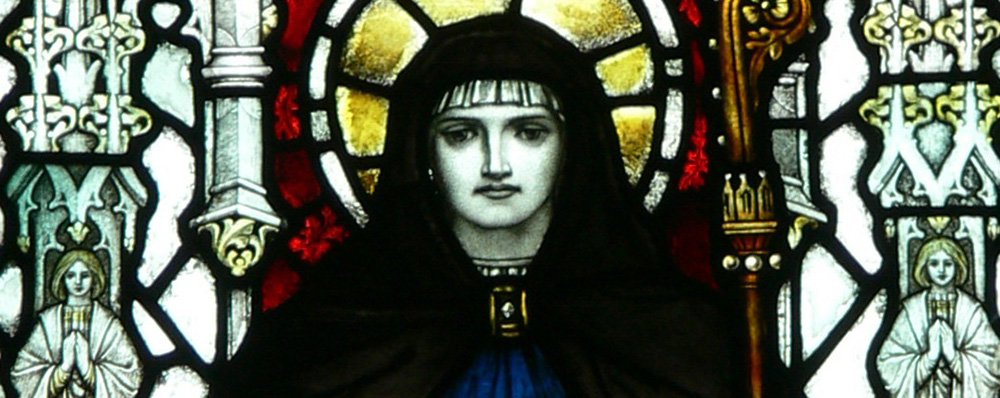Holiness tends to run in families. Many devout parents raise young men to look to the priesthood and pray for their daughters to consider consecrated life. Sometimes God even calls more than one child in a family to religious life.
Rare, however, is the religious who can boast, “My mother was an abbess.” St. Werburgh, an Anglo-Saxon princess who became a Benedictine nun, and an abbess herself, could boast (though she never would) not only an abbess mother, but also a grandmother and great aunt who became abbesses, plus four other nuns in the family: her aunt and three more great-aunts.
All eight of these family members are venerated as saints.
Saintly Relations
Werburgh was born in Staffordshire, England, early in the seventh century. Her mother, St. Ermengild, was a pious, prayerful woman who married the pagan king of Mercia. Ermengild’s strong Christian influence transformed her husband’s life and that of countless others. The king became a Christian, and so did many in his kingdom.
When her husband died, Ermengild became a Benedictine sister at Minister-in-Sheppy, an abbey that had family connections: It had been founded by her mother, the abbess St. Sexburga. Eventually, Ermengild succeeded her mother as superior.
Actually, Ermengild was following in her mother’s footsteps. Sexburga had also become a nun after her husband’s death. After serving as abbess at Minister-in-Sheppy for several years, however, Sexburga yearned to grow in holiness through a quieter, more obscure life. She left Minister-in-Sheppy and placed herself under the authority of her holy sister, St. Etheldreda of Ely.
Nevertheless, obscurity was a luxury not granted to Sexburga. Her gifts of leadership dictated otherwise: She eventually succeeded Ethel-dreda as abbess of Ely.
Saintliness spread throughout this family. St. Sexburga’s sisters, St. Ethelburga, St. Saethryth, and St. Withburga, as well as her daughter, St. Ercongata, were all called to be nuns. So zeal for God was a natural and integral part of Werburgh’s everyday life as she grew up.
It’s hardly surprising, then, that Werburgh felt called to consecrated life. Though her beauty and elegance attracted a number of suitors, her strongest desire was to serve God as a nun. She eventually convinced her father to let her enter the Abbey of Ely, where she was trained by her great-aunt and her grandmother.
Saintly Gifts
Werburgh’s gifts of self-discipline, obedience and leadership were soon apparent. Her uncle, who assumed the throne after her father’s death, asked her to oversee all convents in his dominion.
Werburgh, like her grandmother, was drawn to solitude and desired to live an obscure life. But as with her grandmother, the Lord had other plans. Always obedient, she consented to His will and her uncle’s request.
The saint began her new role by reforming the convents. She also established new ones in Trentham, Hanbury, Staffordshire, Weedon and Northhamptonshire.
Many miracles are associated with the saint. It’s thought that she posthumously orchestrated the execution of her wishes regarding her own burial.
Knowing that all the monasteries in her charge would want to house her remains, she made arrangements to be buried at Hanbury. However, when she died in 699 at Trentham, the nuns there were determined to keep her. They stubbornly refused to transport Werburgh’s remains and even went so far as to lock them up and place a guard at the crypt.
The people of Hanbury, determined to honor the saint’s wishes, crept into Trentham late at night and marveled when all locks and bars fell open at their touch. Guards slept through the entire episode, and Werburgh’s body was spirited away to its resting place in Hanbury.
Due to the miracles and cures that occurred at the saint’s tomb, her body was exhumed in 708 to move it to a more accessible viewing place in the church. Werburgh’s brother, King Coenrad, was present and was stunned to see that his sister’s body was incorrupt.
He was so moved by what he witnessed that he experienced a conversion. Coenrad left his royal post and became a monk.
An Enduring Example
Werburgh’s remains were eventually moved to Chester, where a shrine was built to the beloved saint. She’s the patroness of that town, and a number of churches throughout England are dedicated to her.
When the shrine was destroyed (along with countless other holy sites) under the reign of King Henry VIII, her relics were scattered. Yet, amazingly, by the late 1800s, many parts of the shrine had been recovered and were reassembled. The shrine is still standing today in Chester Cathedral.
Though she lived in an age foreign to our modern sensibilities, St. Werburgh remains an enduring example of devotion, obedience and humility. Like her grandmother before her, she gave up her personal preference about how to serve God, instead doing as He willed. God gave her many gifts, which her family nurtured, and she, in turn, gave the gifts completely back to God.
Holiness does run in families. We may not all be able to boast a band of nuns in our lineage, as St. Werburgh could. But she and her saintly ancestors show us that living, teaching and handing down the Faith will always bear fruit, sometimes in sublime and miraculous ways.
Karen Edmisten writes from Nebraska.

